#Team OSRS
Explore tagged Tumblr posts
Text

jagex continues with the small but incredibly based updates!!!! woo!!! idk if I will personally use any of these but I think they are great options... my DREAM update remains the option to toggle the style of certain equipment pieces independent of your character's "body type" - in other words, on my character model which is in the shape formerly known as the Female player character... I would love to be able to have chest armor pieces NOT be crop tops! ... however I know this will PROBABLY never happen not necessarily bc they don't want to but because it would likely cause a lot more graphical work. ah well. I still love seeing these changes, more options for customization (and inclusivity) is always good!!
#i really appreciate how in the last few years#the osrs team has just been like 'fuck it. we dont care if a subset of our player base throws a tantrum when we make things more inclusive#'we're doing it anyway'#you love to see it#osrs sp
5 notes
·
View notes
Text
worth mentioning that that last pic is simply an apparition of her in the quest Ictharlin's Little Helper, which also appears in runescape 3/modern/whatever u call it and it looks like this

the ACTUAL crondis, the goddess, was actually added to oldschool runescape in 2022. unfortunately they made her oldschool runescape design thin which im mad about. why did they do this to her


every now and then I think about the giant crocodile goddess from runescape and sigh dreamily
#i previously made a reblog abt her osrs design but heres a better one#that also includes the pic of rs3's icthlarin's little helper crondis#osrs team please fix this fatal error make her fat
49K notes
·
View notes
Text
Deadball
Deadball Second Edition is a platinum bestseller on DrivethruRPG. This means it's in the top 2% of all products on the site. Its back cover has an endorsement from Sports Illustrated Kids.
It's also not an rpg I'd heard about until I discovered all of these facts one after another.
I was raised in a profoundly anti-sports household. My father would say stuff like "sports is for people who can't think" and "there's no point in exercising, everything in your body goes away eventually." So I didn't learn really any of the rules of the more popular American sports until I was in my mid twenties, and I've been to two ballgames in my life. I appreciate the enthusiasm that people have for sports, but it's in the same way that I appreciate anyone talking about their specific fandom.
One of the things that struck me reading Deadball was its sense of reverence for the sport. Its language isn't flowery. It's plain and technical and smart. But its love for baseball radiates off of the pages. Not like a blind adoration. But like when a dog sits with you on the porch.
For folks familiar with indie rpgs, there's a tone throughout the book that feels OSR. Deadball doesn't claim to be a precise simulation or a baseball wargame or anything like that---instead it lays out a bunch of rules and then encourages you to treat them like a recipe, adjusting to your taste. And it does this *while* being a detailed simulation that skirts the line of wargaming, which is an extremely OSR thing to do.
For folks not familiar with baseball, Deadball starts off assuming you know nothing and it explains the core rules of the sport before trying to pin dice and mechanics onto anything. It also explains baseball notation (which I was not able to decipher) and it uses this notation to track a play-by-play report of each game. Following this is an example of play and---in a move I think more rpgs should steal from---it has you play out a few rounds of this example of play. Again, this is all before it's really had a section explaining its rules.
In terms of characters and stats, Deadball is a detailed game. You can play modern or early 1900s baseball, and players can be of any gender on the same team, so there's a sort of alt history flavor to the whole experience, but there's also an intricate dice roll for every at bat and a full list of complex baseball feats that any character can have alongside their normal baseball stats. Plus there's a full table for oddities (things not normally covered by the rules of baseball, such as a raccoon straying onto the field and attacking a pitcher,) and a whole fatigue system for pitchers that contributes a strong sense of momentum to the game.
Deadball is also as much about franchises as it is about individual games, and you can also scout players, trade players, track injuries, track aging, appoint managers of different temperaments, rest pitchers in between games, etc.
For fans of specific athletes, Deadball includes rules for creating players, for playing in different eras, for adapting historical greats into one massively achronological superteam, and for playing through two different campaigns---one in a 2020s that wasn't and one in the 1910s.
There's also thankfully a simplified single roll you can use to abstract an entire game, allowing you to speed through seasons and potentially take a franchise far into the future. Finances and concession sales and things like that aren't tracked, but Deadball has already had a few expansions and a second edition, so this might be its next frontier.
Overall, my takeaway from Deadball is that it's a heck of a game. It's a remarkably detailed single or multiplayer simulation that I think might work really well for play-by-post (you could get a few friends to form a league and have a whole discord about it,) and it could certainly be used to generate some Blaseball if you start tweaking the rules as you play and never stop.
It's also an interesting read from a purely rpg design perspective. Deadball recognizes that its rules have the potential to be a little overbearing and so it puts in lots of little checks against that. It also keeps its more complex systems from sprawling out of control by trying to pack as much information as possible into a single dice roll.
For someone like me who has zero background in baseball, I don't think I'd properly play Deadball unless I had a bunch of friends who were into it and I could ride along with that enthusiasm. However as a designer I like the book a lot, and I'm putting it on my shelf of rpgs that have been formative for me, alongside Into The Odd, Monsterhearts, Mausritter, and Transit.
#ttrpg#ttrpg homebrew#ttrpgs#ttrpg design#indie ttrpgs#rpg#tabletop#indie ttrpg#dnd#rpgs#baseball#fantasy baseball#deadball
698 notes
·
View notes
Text
0 notes
Text
My (GORMENGEIST'S) games!
Me and my small team have been cooking up original rpg systems for a couple years now, which has somehow spun into being my college job(!), thanks to all of you.
Consider this a small showcase of the biggest things we've put out so far, seeing as its itch creator day...!
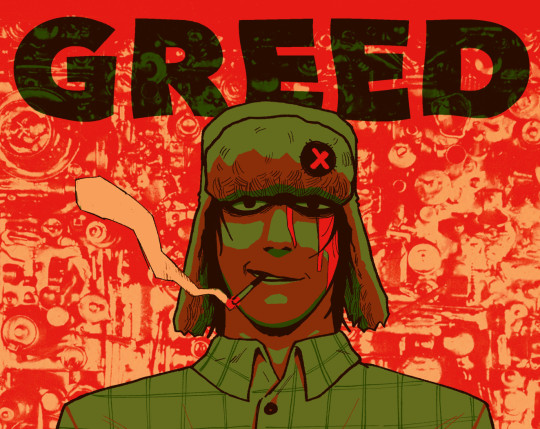
GREED
Our bestseller, our cash cow, our insane idiot kid. GREED is an absurdist experimental OSR game. You may have seen it before in such hits as "check it out, you can play as John F Kennedy in this game." A wide, chewy game without combat crunch.
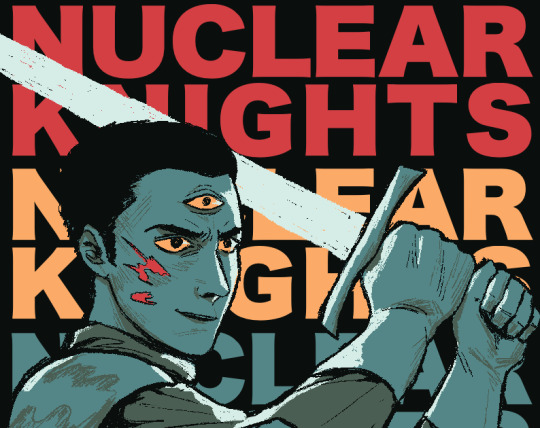
NUCLEAR KNIGHTS
Our largest game, and my personal passion project. A high-fantasy pulp-science-fiction dungeoneering game: wizards and rayguns and psionics and unicorns; heaps of treasure; masters, apprentices, breakthrough power-ups mid fight. All the coolest shit I could think of.

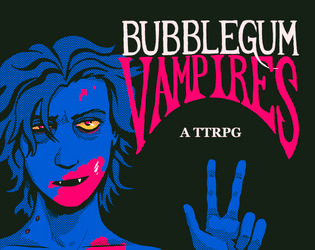
BUBBLEGUM WIZARDS 2 and BUBBLEGUM VAMPIRES
A diptych of relatively short games about an infinite, enmagiced, dangerous city, and two immigrant communities that live there (Wizards and Vampires). Meant to be pliable and imaginative, these are light city-pop games with lots of flavor.

PSYCHOPUNK
Full throttle analog cyberpunk. Uses a unique card-based system, meant to evoke old FPS' like Doom. Dripping with attitude and anger, Psychopunk is one of our earlier games but its clunk may also be its charm.
309 notes
·
View notes
Text

Homebrew Mechanic: Battles of Attrition
I think we can all agree that there’s something a little wonky with how d&d’s combat system changes between the early and mid/late game. Heroes go from being rightfully cautious about danger to being outright banal about it, confident that their accumulated power will be enough to dispatch all but the most outstanding foes. The traditional solution is to put them up against stronger enemies but in my experience these mismatched encounters are a failing proposition: combat just gets more swingy and there’s only so many high level threats I can throw at them in a short period of time before it begins to strain credulity.
While a lot of folks (Especially the OSR crowd) have taken the stance that 5e is broken because of how much it empowers players, I think the real fault lays with the lack of systems that exist to provide challenge outside of anything related to the damage based tug-of-war that is combat. I think a lot of those systems were part of the non existent “exploration” pillar of the game before Hasbro realized they could make easy money selling the game in its unfinished state and gutted it along with the development team.
Thankfully, I and other homebrewers are around to do what the megacorporations cant, namely have some original thoughts and try and figure out a way to add challenge back to the game without resenting those playing it for having fun.
TLDR: Trying to make our games challenging by upping damage numbers in combat is a losing proposition, in no small part because that part of the game is DESIGNED around the heroes winning. Instead, we up the overall difficulty by making them temporarily weaker with systems like sickness, stress, exhaustion, & item degradation. All of which I have details and guidelines on below the cut.
First and foremost let me state some of my goals for these “attrition systems”, so we can all be on the same page. Whenever I make homebrew rules I try for something that’s going to require little to no paperwork on behalf of the players and can be seamlessly implemented into my DMing style. It’s not about realism, it’s not about punishing players, this is a way for me to add mechanical depth without bogging down the machine entirely.
Attrition should be largely non-permanent. The 5e audience invests a lot in their characters both emotionally and mechanically, so it won’t do to pile on debilitating debuff after debuff to the point of making a character useless.
There should be an inverse relationship between the severity of the affliction and how long it lasts. Think in term of encounters, days, or weeks, (with the understanding that an attrition that goes on for long enough becomes a questhook in itself)
The exception to this rule is if someone hits 0 hitpoints. I’m outspoken in my stance that characters should only die when it’s alternatively appropriate, but the dm is at liberty to inflict thematically devastating setbacks in the unlikely event that the party DOES suffer losses in the damage tug of war.
We want to be sparing with how much attrition we throw at the party at once, so as to not create a “death spiral” where failures compound upon one another and make getting through the adventure impossible.
In most cases suffering Attrition should be something the party is able to avoid by being fast/lucky/cautious/clever or whatever else the encounter requires. It’s there to add weight and consequence to their actions, and as a factor for DMs to build scenarios around.
Exhaustion: Unlike a lot of the other changes made in Oned&d, I actually quite like the overhaul of “each point of exhaustion is a cumulative -1 to all d20 rolls and spell dc, beyond 10 is death” as it allows us to play with exhaustion far more readily as an attrition.
Every night you don’t rest in a haven (a safe comfortable place) you need to make a con save or take a point of exhaustion, with the ruggedness of the environment determining the DC. Characters with the survival skill or natural explorer feat don’t have to make this roll. Only rest in a haven removes exhaustion at the rate of one point per night (though spaces like a luxury inn or a peaceful glade watched over by friendly fey may restore more)
Hitting 0 hp and then being healed gives you a point of exhaustion. Nothing’s going to tire you out like getting magically defibulated so now everyone can stop complaining about healing word spam.
Poison: For our purposes, the “poisoned” condition as written is too severe. Disadvantage on all attacks and ability checks is downright punishing for anything other than a single battle. Instead we’re going to make it work like charmed, where there’s a baseline effect for the purposes of resistance, but the status of each poison is dependant on the source.
Poison falls in the “ short term big effect” side of attrition, specifically undermining a player’s ability to do most things since most effects end on a successful save or at the end of an encounter. Long lasting poisons should have more minor effects than the default poisoned condition, only applying to a few types of rolls or having a bane-like effect that makes judging the odds just a little bit more difficult.
This makes poison great to use for dungeons and short-ranging exploration where the party is likely to face multiple encounters in one day.
Diseases: 4e aced the design of these maladies by treating them as a contained skill challenge with their own CR with various stages: stage 0: you were cured, stage 1: you suffered the initial effect, stage 2 or 3: you suffered a severe effect, with the final stage (3-4) being some effect that made the disease permanent. When you got a disease it was usually stage 1, and you (usually) saved for it at the start of each day. Beating the DC by 5 or more meant you went down a stage (closer to 0), where as simply succeeding meant it stayed as bad as it was. Failing meant you got sicker, meaning a character could bounce up and down in wellness as an adventure went on.
Diseases are best for longterm adventures, and often undermine one particular aspect of a character ( healing, actions assosiated with a particular stat). Counterpoint to poisons, diseases should start out fairly gentle and then get worse the longer they’re left alone, leading to eventually devastating effects.
Curses: While borrowing the mechanics of diseases, I’d have curses be specifically weirder in their effects. The sort of thing that can make up the central hook or b-plot of a whole adventure. This should also mean that curses are the hardest for the party to stumble into, but also the hardest to shake.
Item Degradation: Detailed in a previous post HERE, the long and short of it is that item degradation is a form of player driven attrition that gently curbs their overall power level. If they go too hard, use their best items recklessly, get involved in needless fights, then they’re going to be in worse shape by the time they reach the final challenge. This was supposed be the idea behind HP/limited class abilities per day, but attrition systems cover that better IMO.
Stress: The psychological counterpoint to exhaustion, I’ve already talked about Stress HERE. I tend to only use stress in horror themed adventures and campaigns, as it builds upon 5e’s optional “madness” system which fits the theme when gothic terrors and eldritch abominations but less so with the game’s usual heroic fare.
Hunger & Supply: I made a super lightweight system based off this idea of “depletion die” for potions and other consumables, check it out, it’s lightweight and fantastic. Using this kind of system gives us another avenue to challenge our party, lengthening or shortening their lifeline as they lose supplies and seek out new caches.
Thinking environmentally: Part of the fantasy of being an adventurer is travelling to dangerous places and living to tell the tale. We’re denying our party that fantasy if we don’t follow through on the threat the idea of these places imply. You should risk sickness if you go into a swamp, sewer, or jungle, thirst should be a factor in desert exploration, just like freezing is for mountain and winter expeditions. That’s to say nothing of magical hazards; cursed landscapes that drain your will to live dead marshes style, alchemical smog in a steampunk industrial zone, fading into nothingness as you approach the edge of existence.
Figure out the natural hazards, make your party aware of the danger, and then build your adventure around the fact that they’ll need to save against the hazard each time they take a long rest.. Do they take a detour if it means having a safe place to camp? Is there a resource they need to manage along the way? Could encounters expose them to further dangers or make their current exposure worse? Keeping these ideas in mind especially when you’re planning a wilderness exploration adventure should give you lots of ideas to fill up those encounter tables.
Adding insult to injury: Giving enemies the ability to inflict attrition in various forms makes otherwise trivial enemies a credible threat even to a seasoned adventuring party. As an example, A party might breeze through a fight with some monstrous spiders ( or even ONE regular sized spider, if you can imagine) , but that spider encounter doesn’t need to be the most dangerous thing ever if their next encounter is a navigation challenge fording a river and a few of the heroes are still groggy thanks to the slow acting poison in their systems.
In this way you can use attrition based battles to soften your party up for greater challenges, long after their HP totals and healing ability have outpaced the damage a single trap/encounter can do.
Artist
307 notes
·
View notes
Note
Do you know of a ttrpg where travel is the main focus? Like I tried one ring and travel felt like a mini game rather than a key feature
THEME: Travel (Part 2)
Hello friend, so I’m firstly going to link you to this Travel Recommendation Post I put together in June of last year. (It’s a lot of posts and I didn’t tag it very well! Working on remedying that.)



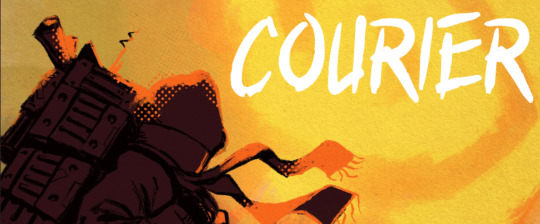
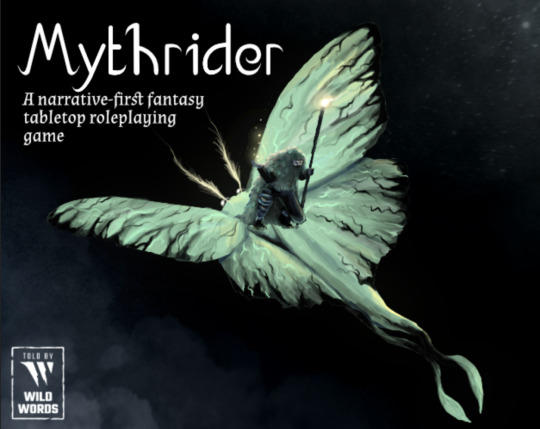
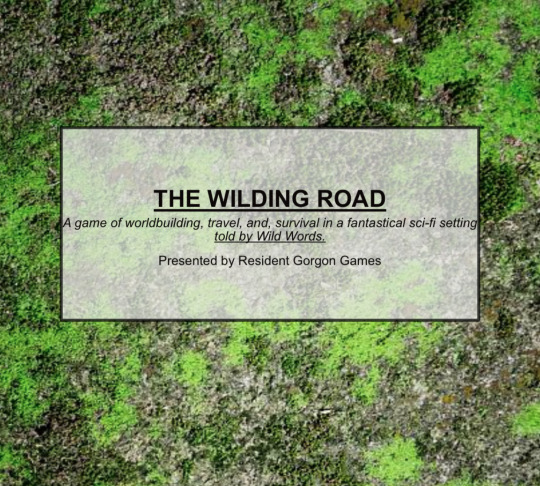

Rig Rats, by kyusenbo.
The year is 30XX, and climate disasters and human negligence have brought the world to its knees. Only large, corporation-run cities remain, surrounded by large, climate-controlled domes. However, in order for these corpo cities to send and receive goods and services between each other, we need Rig Rats. These are ragtag teams of big rig operations rogues, needed to run rigs on the desert roads, to ensure that these deliveries make it on time through radar attacks, bad weather, and poor road conditions.
Rig Rats takes prime inspiration from Mad Max, and while the game itself is just two jpeg images with a list of rules and a few scribbles, just by reading it I think it can deliver that kind of high-octane experience. Each of your characters has a role on the rig, such as Driver, Mechanic, or Lookout. You get to decide what you’re carrying, and why your cargo makes things complicated.
Each session is a single trip from one city to another, so it makes the game great for one-shots, and the number of obstacles that can come up make your trip truly harrowing. Will the rig break down? Will you run into rival bandits that want your cargo? What about environmental hazards, like minefields or electrical storms? What if a singular guy in a really modded-out car shows up and kicks the shit out of you because he wants your gasoline?
Anyways, you should check out Rig Rats.
Gone Too Far, by The Badger’s Den.
Gone Too Far is a GM-less rules-lite narrative game about travelling to distant planets. It can be played as a solo journaling game or as a collaborative roleplaying game for up to three players.
Far in the future, mining & scientific corporations send scouts to distant places to find suitable expansion locations or useful resources. They use a risky teleportation technology that is high risk / high reward, as there is a chance the user will go out of range for a return journey.
You (and your friends if playing together) play as one of these scouts going to lost places and mineral-rich planets.
While much of this game is exploration-focused, the danger of travelling too far is central to the premise. You are voyaging to new and wondrous places with heavily experimental and limited technology; the possibility that you don’t make it back makes the portal roll incredibly important to the game, even though it only happens at the end of a player’s trip. You play this game over and over series of rounds; the player experience can be rather siloed from other people at the table, unless you choose to use an optional aid mechanic. As a result, I think Gone Too Far might work rather well as a solo or duet game, and is a great option to consider if you like themes of travelling through space.
Ferryfolk, by cthos
Another day, another fare, another series of mysterious islands to traverse. You are a Ferryfolk, though there are those who call you by an older name: Psychopomp. Your job is to guide lost souls down the river Styx and see them to their final destination unharmed and hopefully having learned a life lesson or two.
Only the weirdest and most difficult cases draw multiple Ferryfolk to a single boat, and you've been selected for the job! Travel from island to island facing the Fare's fears and memories and guide them to be a better person before they reach their Destination.
As a 24XX game, Ferryfolk is rather rules light, with everything you need to play in just 5 pages. It carries elements I typically associate with the OSR (roll-tables, high amounts of danger, upgrades in the form of gear), as well as elements I typically associate with story games. The primary piece that feels story-like is rooted in the cargo your characters are ferrying across the River Styx: people.
Your passengers have personal problems that they’re wrestling with, and part of your journey must include visiting various islands, which contain memories that the passenger must work through if they are to overcome their personal fears. These passengers have a fear track, and risk becoming lost should they run into the wrong kind of hazard.
The fact that your boat has a distinguishing ability that gives it a unique advantage, as well as potential companions that can make your journey easier, makes this game both solo-friendly and suitable for a small campaign. If you liked the video game Spiritfarer, I think you might like Ferryfolk.
Courier, by Sleepy Sasquatch.
Courier is a solo-RPG where you take control of a Courier—someone who travels the Wasteland delivering and trading cargo in exchange for REP, the currency of this post-apocalyptic future. As you explore the world around you, locations and factions are revealed and recorded on your map. Choose to take jobs for factions and build reputation to access new benefits all while becoming better at your job and earning new character perks.
You will continue to take on quests delivering, recovering, or scouting the map for one of the many factions populating the Wasteland. Every choice you make as a Courier will reflect how these factions view you and open new opportunities and bonuses as your standing increases, or decreases through a fame and infamy system. Choices will have you siding with a few select factions by the end of your game and seeing the world change for it.
If you are a big fan of Death Stranding, I think you might like Courier. The game is all about exploring a wasteland and delivering items from one location to another. The game involves revealing hexes and tiles, so moving in a certain direction on the map can have really big consequences.A really large chunk of the game is focused on exploration, and that includes creating routes and shortcuts between locations: basically, improving your map to make future quests easier to complete. New locations give you both obstacles and opportunities, with both hazards and interesting scavenge that might be useful in keeping you alive.
The designer for Courier also has an updated version of this game called Courier - Repacked Edition, which they are very proud of - however I don’t own a copy of that game so I don’t know what exactly has been changed in the second version.
MythRider, by Natalie Jones.
When the great fires died and the distant reaches of civilisation were plunged into darkness, Riders were called upon to chart the dark. Explore the uncharted wilderness of a supernaturally huge forest, call forth legends into the world and bend magic through the wings of dragonflies.
Mythrider is a rules-light fantasy roleplaying game using the Wild Words engine to tell stories about knightly heroes and their giant insect steeds.
Like Wildsea, which uses the same system, MythRider has a whole type of scene dedicated to travel. Typical of a Wild Words game, you have a danger track that fills every time you run into trouble or move too fast, and a distance track to indicate how far you have to go before you reach your destination.
Games like this aren’t incredibly granular when it comes to any specific mechanic; many parts of the story can be abstracted out, including a montage that you can partake in whenever your crew has downtime at a settlement. This abstraction means that you can draw out the moments that mean the most to you, especially travel.
The setting for Mythrider is fantastical, with a really iconic set-piece of gigantic dragonflies and other insects that you can ride. I think these unique setting pieces make the game a compelling sell to any interested game group.
Wilding Road, by Resident Gorgon Games
Aldea was once a far flung colony of Earth. The people lived easy, carefree lives in a society fueled by clean, renewable energy and maintained by a benevolent AI known as the Overseer. Until the Collapse.
Something went horribly wrong with the gate in orbit, causing it to shatter and bring ruin to the world below. The lucky ones were able to escape and build a life on Aldea’s moon, Duru. Those left behind struggled to survive and what remained of the Overseer and Aldea’s infrastructure fought to return the planet to the garden it had once been.
Caravaners make a living by traveling between these pockets of society and civility. But, the road makes for a hard life. Even with beasts and bandits, the Overseer is constantly on the look out for those that would disturb its work of returning Aldea to what it deems as perfect. So, Rigs must walk the line of being able to travel but go unnoticed by the world around them, lest they be discovered and draw ire.
Wild Words games are typically great about travel: in this case, you also have the added difficulty of moving from point A to point B without getting noticed by something big and powerful.Your characters have a rig, which you use to cross the weird wilderness. You have a threat track, which is marked whenever the Rig runs into trouble, and eventually will likely introduce a hazard of some kind. You also have resources, in the form of both cargo that you are carrying and scrap you might discover, which can make the journey easier.
The designer for this game is doing a lot of work with this engine, making Realm, a fantasy game about exploring a world of spirits and wonder. If you like the ideas presented in Wildsea, you might want to check out these games!
Aquanautica, by Old Grog
Aquanautica is a subaquatic sci-fi setting inspired by the Aquazone Lego sets from the ‘90s. It takes place on Tethys-95, an oceanic, alien world filled with mystery and adventure. It was designed for use with tabletop roleplaying games but is system-agnostic and therefore doesn’t require any specific game system to play.
Aquanautica is a hex crawl setting that has a very colourful and useful map. This map has icons to represent different locations and environment types, as well as a colour reference to represent how deep you are at any given hex. The game comes with some dangers: running out of power or oxygen can bring your journey to a pretty definite end, and it will also make your navigation incredibly important: how far or deep can you go before you need to turn back?
The game has a lot of tools to help generate the setting and make it feel alive: there’s a roll table for encounters, some factions that will be trying to lay claim to parts of the setting, and a creature generator. There’s also a cave system generation process, which includes tunnels and additional dangers of getting lost and racing against the to find the exit.
This isn’t a game in itself - it’s an adventure setting for another game. I think a game like Mothership, Into the Odd, or perhaps a Tunnel Goons hack would be appropriate systems for Aquanautica.
Other Recommendation Posts To Check Out
My Isolation and Desperation post which had some funky recommendations for a person looking to craft a spooky road-trip.
My Pacific Drive Recommendation Post.
My Exploration recommendation post.
47 notes
·
View notes
Text
Some History of Eureka: Investigative Urban Fantasy

youtube
Brandon and I have played a lot of TTRPGs, from nearly every edition of Dungeons & Dragons to half-finished playtests of things you’ve never heard of. Our history with TTRPGs is a love story, but one pockmarked with frustration. We found ourselves enjoying D&D 3.5’s vast character creation options, but wishing it focused more on grounded characters and historically informed combat; being drawn in by Call of Cthulhu’s horror and existential dread, but disappointed in its investigation mechanics for actually getting the investigators to those moments of horrifying revelation; being intrigued by Monster of the Week’s juxtaposition of both normal and supernatural PCs (for horror and/or comedy), but finding its lack of character options and reliance on genre tropes a hindrance; being unable to find anything that would be good for a S.T.A.L.K.E.R. inspired TTRPG campaign. We eventually found the OSR movement and AD&D1e and 2e to be far closer to what we wanted on the medieval fantasy front, but we still had nothing on the modern horror or urban fantasy front, and Shadowrun is… Shadowrun.
So, with around 20 years of TTRPG experience between us, we set out to make the game we wanted a reality.
The story of Eureka: Investigative Urban Fantasy’s creation really starts in late 2021, when Brandon asked me to help playtest a very early rough draft of an investigative horror game he thought up. Living isolated, impoverished, and unable to find work in England at the time, I readily agreed. Noticing that the game didn’t have a combat system and desperate to set my mind to something constructive in between tedious job applications, I offered to write a combat system for it. I soon had to use the last of my money to move back home to Louisiana where I eventually did find work despite a variety of health issues, and continued to work on Eureka as a system for our personal use.
As 2023 drew near, it became clear that my current job wasn’t going to be a permanent career, and I needed a fall back plan. Work towards making Eureka: Investigative Urban Fantasy a professional release began in earnest, with Brandon and I founding A.N.I.M. a few months later. It was initially set to go to Kickstarter in April of 2023, then May, then June, but each time we realized it just wasn’t ready. No one had ever heard of us, and we wanted to break into an industry and customer base increasingly financially hostile to any TTRPG that wasn’t D&D5e compatible. We needed to build an audience, and build a greater appreciation for independent and small-budget TTRPGs within the community at large.
Thanks to some assistance from one of the team members from Tuesday Knight Games (makers of Motherhship), the first beta copies went public in September of 2023 to a splash of instant (relative) success, and the A.N.I.M. TTRPG Book Club was founded on Discord two months later, a community dedicated to buying, playing, and analyzing less well-known TTRPGs - which includes almost everything except Dungeons & Dragons 5th Edition.
Ash became friends with us through the book club, and after offering an increasing amount of assistance, joined the team proper in January of 2024, adding much needed copy-editing skills as well as another 15 years cumulative TTRPG experience.
The Kickstarter campaign for Eureka: Investigative Urban Fantasy launched on April 10th, 2024, was fully funded within 3 hours, and by the end of the campaign had reached a total of $15,455, 486% of the goal. That is where we are at now, working every day to put the finishing touches on the game and complete the stretch goals to the best of our ability before our tentative deadline of January 2025.
This is a far more ambitious project than a super-small team like ours should have attempted for our debut game, but with a mix of talent, luck, skill, and a whole lot of help, we have somehow managed to pull it off. We think the resulting game is a deep, robust, professional-quality TTRPG that provides a one-stop shop and extensive toolbox for any investigative or mystery game you’d like to run. A dark and moody noir, a classical British whodunnit, the lighthearted sleuthing hijinks of Scooby-Doo, Eureka does it all. (You can also get the latest PDF for FREE for a limited time by joining the A.N.I.M. TTRPG Book Club!)

Elegantly designed and thoroughly playtested, Eureka represents the culmination of three years of near-daily work from our team, as well as a lot of our own money. If you’re just now reading this and learning about Eureka for the first time, you missed the crowdfunding window unfortunately, but our Kickstarter page is still the best place to learn more about what Eureka: Investigative Urban Fantasy actually is, as that is where we have all the fancy art assets, the animated trailer, links to video reviews by podcasts and youtubers, and where we post regular updates on the status of our progress finishing the game and getting it ready for final release.
Beta Copies through the Patreon
If you want more than just status updates, going forward you can download regularly updated playable beta versions of Eureka: Investigative Urban Fantasy and it’s adventure modules by subscribing to our Patreon at the $5 tier or higher. Subscribing to our patreon also grants you access to our patreon discord server where you can talk to us directly and offer valuable feedback on our progress and projects.
The A.N.I.M. TTRPG Book Club
If you would like to meet the A.N.I.M. team and even have a chance to play Eureka with us, you can join the A.N.I.M. TTRPG Book Club discord server. It’s also just a great place to talk and discuss TTRPGs, so there is no schedule obligation, but the main purpose of it is to nominate, vote on, then read, discuss, and play different indie TTRPGs. We put playgroups together based on scheduling compatibility, so it’s all extremely flexible. This is a free discord server, separate from our patreon exclusive one. https://discord.gg/7jdP8FBPes
Other Stuff
We also have a ko-fi and merchandise if you just wanna give us more money for any reason.
#roleplaying#indie game#indie ttrpgs#ttrpgs#ttrpg#ttrpg tumblr#indie ttrpg#ttrpg community#ttrpg design#poverty#england#louisiana#mothership#call of cthulhu#dungeons and dragons 5e#dungeons and dragons#shadowrun#osr#monster of the week#motw#pbta#blades in the dark#tabletop#monsters#eureka#eureka: investigative urban fantasy#rpg#Youtube
93 notes
·
View notes
Text

“Why Do Your Actual Play Videos Look Like Ass?”
ROUGH BUT FAIR
I got asked this, albeit indirectly, back in January. At the New Year’s Open Hearth Community meeting someone relayed they’d heard this comment about our Actual Play videos. This referred to not just my channel, but our community collection of actual plays built up over eight+ years.
It’s a lot of sessions. A lot of games. My stuff alone is over 1000 sessions over dozens of systems.
And it’s a fair question. They might stumbled on to one of our video roundups or seen a session shared. I can understand their reaction, especially if they’ve watched heavily produced and edited videos like those from Critical Role or Dimension20. Or even if they’ve followed one of the many talented teams who stream on Twitch or elsewhere with seasons, transitions, and nice visual templates. They’re all great watches– especially streams featuring indie games and diverse casts.
So what’s up with us?
Answering that question takes a little bit of set up and explanation.
The short answer: You know that reliable YouTube repair video recorded on a phone by someone in their garage? That’s us.
The long answer…
WHAT THE WHAT IS OPEN HEARTH?
We’re an online tabletop rpg community. We’ve been around in some form since 2016. Game facilitators post series and sessions on our calendar and people can sign up there. Every game’s run under our code of conduct and has to use a layered set of safety tools. Our GMs teach any rules and while we lean into indie and storygames, we also have folks who love OSR and more trad-leaning games (like my runs of 2d20, GUMSHOE, Imperium Maledictum, 13th Age, and the like).
We have a patreon which gives backers a 48 hour window to sign up for sessions before they’re open generally. But we also have folks running games specifically for new players which set that aside. We’re always looking for ways to get new folks into sessions– like the open gaming events we do a couple of times each year. After folks have played with us a couple of times, they’re welcome to post their own sessions and series. We also do irregular “Game Facilitator Camps” to help people learn and polish their online GMing skills.
Since the beginning some of our GMs have videos of our sessions and collecting those on our YouTube channel. Game facilitators mention in their event description if they plan to record. Not all sessions are recorded and posted. It’s not a requirement. In most cases, players can say they’d rather not be recorded– and in all cases a GM needs to confirm before posting any session publicly. For example a couple of times I’ve had folks ask for me to trim out personal info or emotionally fraught moments from a session.
All of these recordings are rough. They’re the raw play of the session: unedited and wysiwyg. I’m recording from Zoom, some folks use Streamyard, and a small group of the more technically savvy use OBS+. On occasion I remember to pause the recording over breaks or during character creation when everyone’s tooling away on their sheets. But generally it’s like sitting in the room while someone’s running a home game. They’re messy, mostly on topic, trying to get to grips with the rules, figuring things out together.
And I love it for that. They’re not polished. A comment made in connection with that “why do your APs look terrible?” question suggested we were some kind of ‘elite gaming association.’ I fear that impression might come from my posting a lot of game thinking, history, and analysis in our social media feeds.
The truth is that I post those things in a desperate bid to have content. In our community we mostly talk about what games we’re playing and what games we want to play.
Bottom line: we’re a bunch of folks getting together to play our elf-games, make silly voices, and try to tell fun stories together. We’re trying to do that in a way that’s inclusive, takes safety seriously, and evolves over time.
So why post actual play videos in such a state? I have some answers, in order from most important or probably least important…
FIVE REASONS
First, these videos shows how a particular game actually works at the table. Our community plays a lot of different games– I’d argue one of the largest collections of different systems. It serves as a great resource if you’re curious about a game, setting, or system. Most of us who record include our session zero as well as play sessions. So you get to see what’s involved with that, how to manage set up, and the kinds of collaboration which happens. You also see, warts and all, the rough patches and stumbling blocks.
For example, I love Hearts of Wulin, but building Entanglements takes a lot of work during character creation. Don’t get me wrong: it's also the most important. Entanglements up the conflicts and plots you’re going to explore. But it requires you to both do some heavy creative work and listen to the other players at the same time. Sometimes I manage that phase really well– sometimes I forget that it has a higher cognitive load. Then I have to lean in and help folks navigate creating those.
In a similar way, our AP illustrate the flow of play. What does resolution involve? How long does combat take? Where do folks get bogged down? That’s useful and can tell you if this is a game you’d be comfortable playing or running. Beyond that you get to see how much people seem to be enjoying and engaging with it. We present the naked truth of the game. All the rough edges remain and I think that’s great. It’s not for everyone— especially if you like a more polished presentation.
Second, you get to see safety tools in action. If you want to know how GMs carefully present a layered set of safety tools, watch a couple of session zeros. Different game facilitators will approach this in different ways, but we stress that GMs explain and actually implement a couple of tools. In my case I use Lines & Veils as a baseline, the X-Card as a reactive tool for resetting & calibration, and Open Door so folks know they aren’t trapped in a game. You can see how these tools don’t present a burden, don’t get in the way, and do enhance play. It reduces some of the worry people may have about joining a group of strangers online. It isn’t perfect, but these tools offer a baseline. I’m a white dude with all the privilege that brings, but I wouldn’t join in a random online game unless I knew tools like those were in place.
Third, like other online streaming games: curated, edited, or otherwise, you get to see good GMs and players in action. It’s a great way to learn and pick things up. Not necessarily the full-on art of theater and improvisational acting, but what good play looks like. How you move the spotlight around. How you work to bring others into your scenes. How you collaborate to build a setting and vibe. How you handle end of session debriefs and feedback. That’s useful and, I think, confidence building.
Fourth, and more selfishly, these videos are a decent advertisement for our community. It’s a decent and cheap way for us to keep our name out there. Beyond the videos, as I mentioned above, people can listen to these sessions as podcasts now. It’s also a way for us to boost the work of designers. It’s not a review, comment, or five stars but it does show how much we’ve enjoyed a particular game. I always dig it when I see designers resharing sessions, I hope it helps them increase their audience.
Fifth, I like having those videos out there because they celebrate our GMs. They’re the engine of our community: folks who enjoy running games and put in the effort to entertain and engage a group of folks. We have amazing game facilitators and what strikes me is how different their approaches can be. I learn something new whenever I play with another GM here.
But on a related note, I will admit that I like having cover for my vanity. By placing my sessions alongside others, I manage to conceal how much my posting these sessions is an act of ego. I’m more than a little vain about my GMing.
STARS AND WISHES
Overall we hope to be a useful and accessible resource for folks playing ttrpgs online. We hope folks will find their place in this hobby. If someone comes and plays with us, that’s great, but we’re more interested in just getting people to play anywhere.
If you want to check out our collection of Actual Play Sessions, like and subscribe to our YouTube channel.
If you’re interested in just listening to sessions, you can subscribe to our podcast.
If you want to see the Playabl calendar app we use for organizing
If you want to find out more about our community, see here.
We have Discord we’re working to do more with.
38 notes
·
View notes
Text
AVE NOX & BEYOND THE PALE
Two HUGE kickstarters that I am really excited about today! I've gotten to watch their development from early on and I can say that I've not been more excited for any TTRPG books for quite a long time!

Ave Nox, a system neutral megadungeon of Forgotten history and disaster deep in the dark of the Earth!
https://www.kickstarter.com/projects/appalachia-gothic/ave-nox by @feralindiecharlie
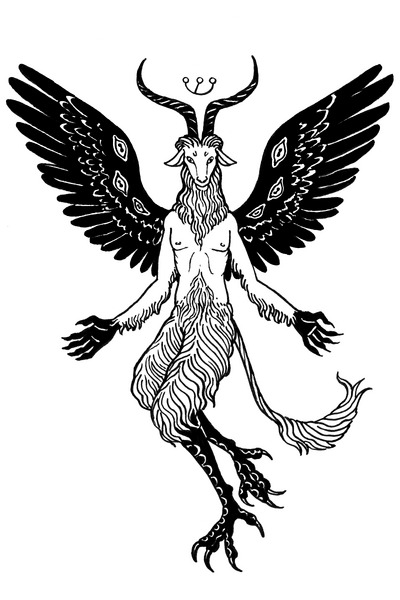
Beyond the Pale, a horror Osr adventure, inspired by Jewish folklore and mysticism!
https://www.kickstarter.com/projects/lost-pages/beyond-the-pale-a-folktale-adventure by Yochai Gal, @sheydgarden, Shari Ross, Eli Seitz and Paolo Greco as well as an extensive team
#ttrpg community#ttrpg#indie ttrpg#roleplaying games#ttrpg design#ttrpg art#ttrpg stuff#megadungeon#dnd#osr#dungeons and dragons#adventure#jewish folklore#illustration#character design#jewish art#jumblr#beyond the pale#yochai gal
116 notes
·
View notes
Text
331% Funded | 15 days to go!
If you've been following me for a while you'll know I'm soon going to be releasing The Perilous Pear & Plum Pies of Pudwick, a 52 page full-colour, fully illustrated adventure for Melsonia where a group of plucky adventurers will shrink to insectoid size and adventure into the uncanny world that exists inside a sapient pear tree in a system agnostic weird fantasy bugcrawl.
If that interests you, you should absolutely check out Beetle Knight, which I hope to run TPPAPPOP with when I get my grubby palps on it!
Beetle Knight has got a cool contested rolls system, an emblems mechanic reminiscent of the medals in Bug Fables or charms in Hollow Knight, and it comes from a team embedded in the OSR/NSR design trajectory.

I'm not involved with Beetle Knight, but if luck is on our side both projects will release the same day Silksong comes out! If it sounds like your kind of game (and you know it is if you're following me) go check out the kickstarter page!
#indie ttrpg#ttrpg#ttrpg design#ttrpg recs#tabletop#bugs bugs bugs#ttrpg dev#beetle knight#hollow knight#silksong#bug fables#insects#osr#ttrpg community#kickstarter#ZiMo#zinequest#zine month#solorpg#rpg#indie rpg
52 notes
·
View notes
Text
So I'm sure that you know how jagex turned Burthorpe into the starter area of rs3 Where the tutorial is and all the new player skill guides are. And has graphically reworked everything including the buildings and the people. And you know how since jagex released Necromancy as a skill they allow you to see the ghosts of canonically dead npcs in Um. And technically allows some interaction with them. And you know how mod Raven said that one time around the release of Nomad's elegy, that the rs3 team actually regrets killing Cyrisus during WGS? And you know how in Path of Glouphrie Hazelmere told you of the 8 npc's sent to rescue you, 2 will survive, one representing the path of the warrior and one representing the path of the slayer?
And you know how one of these 2 NPCs, specifically the one representing the path of the warrior, is Harrallak Menarous, the most irrelevant npc in Burthorpe, so irrelevant in fact that in 2 graphical updates they haven't fixed his coif ass hair clipping through his hat? And haven't even added any dialogue to him since the Necromancy release, not even some generic "hey since u talk to the spirits of the dead, can you pls buy Ghommal and Sloane a pint?" With a "thanks" and some cosmetic rapier as a reward or whatever? So are the OSRS team gonna stick beat for beat to the original WGS script and let irrelevant nobody Harrallak live while killing Cyrisus for the shock value (which will shock no one bc we all knew it was coming) or are they actually gonna do what the rs3 team couldn't by letting Cyrisus live and continue his character arc by either: 1. Going to work @ the warrior's guild, even if only temporarily now that they have so many vacancies, possibly rising in the ranks until he becomes guildmaster or at least in charge of one of the rooms like Sloane is now (Because even if he doesn't rise to become guildmaster, I'd much rather buy the strength cape for example from Cyrisus who demonstrated strength by his willingness to carry on despite reaching rock bottom before we met him in Dream Mentor than from some quaternary NPC like Yadech Strongarm who didn't even EXIST prior to wgs), thus paying the player's kindness forward by being a guide to others the way the player was a guide to him? or 2. Making him a Slayer Master / Slayer Master in training, since his npc contact dialogue about hunting the Kalphite Queen suggests he already is on frequent bossing trip terms with the other Slayer Masters and could possibly be training with them. He is so good at combat and slayer at this point that maybe he's learning slayer master minutia from his slayer master buddies during those current trips as we speak, and is reasonably close to graduating to slayer master himself, and he's as good a candidate to replace one of the fallen slayer masters soon anyway, which will also complete his character arc by making him a guide to learners the way the player was to him, just in an aspect he seems to be happy with on his own without being introduced to it by others.
Or, maybe, they can just let him live and do something else thing that will not involve combat directly bc he seems to be meeting with world leaders on his off time and discussing weird secret stuff so he can be involved in trying to help us somehow through that. Or even write their own ideas. I mean, osrs has a writing team of people who, from what I've seen, can actually continue a story and don't need to directly copy paste every last thing rs3 does into their game. Why not develop an existing character instead of killing him for the sake of avoiding killing some other overhyped loser (Lucien) that will die in the wgs sequel anyway??? I mean surely they can spare some character development for Cyrisus this time around instead of letting him die simply to shock the 5 people who don't skip quest dialogue and very slightly like him bc he was in a quest once?
#long post#runescape#rs3#osrs#rs Cyrisus#*rattling the bars of my cage*#DEVELOP YOUR CHARACTERS DEVELOP YOUR CHARACTERS DEVELOP YOUR CHARACTERS DEVELOP YOUR CHARACTERS DEVELOP YOUR CHARACTERS DEVELOP YOUR...#I would apologize for dropping this on you all but I dropped something similar in a discord with people who just didn't react at all#And I kinda both want either validation or counter opinions or SOME sort of conversation about that
14 notes
·
View notes
Text
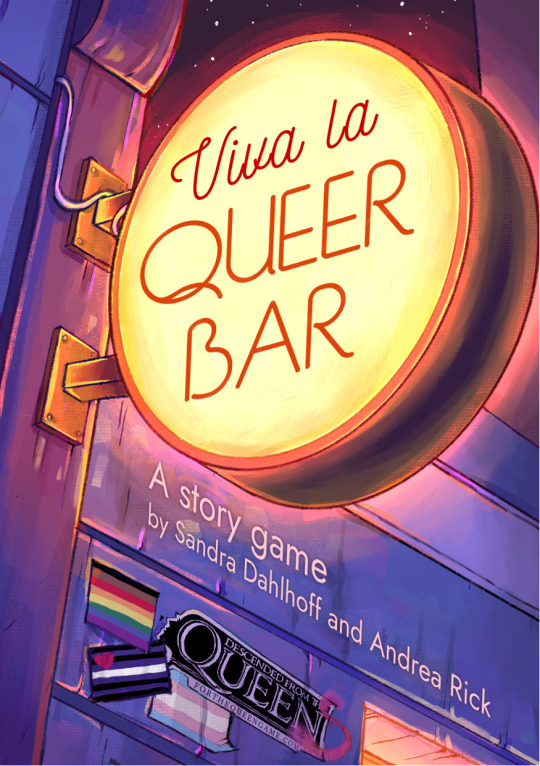
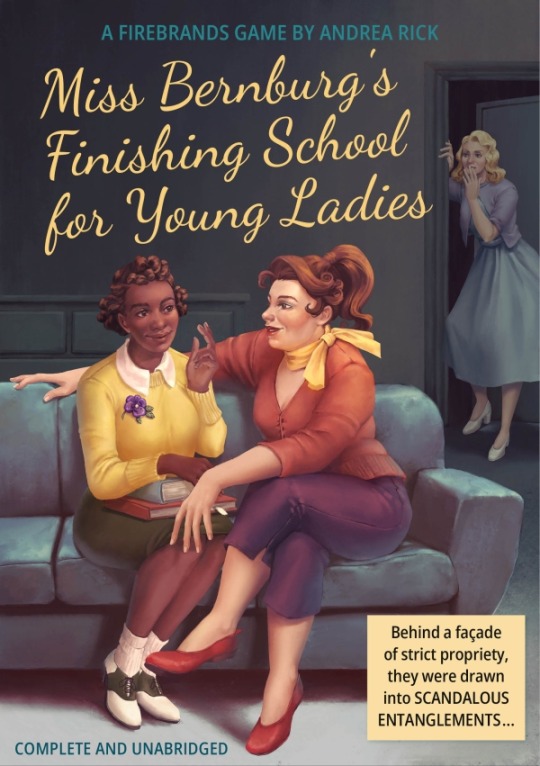
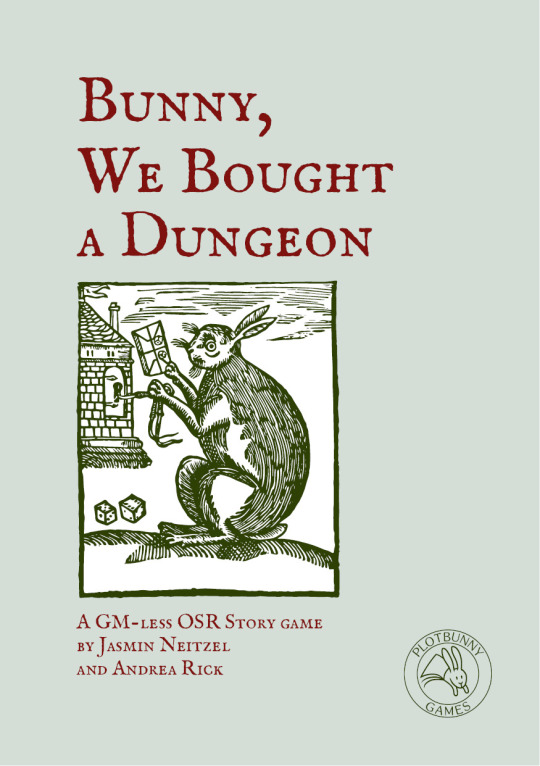



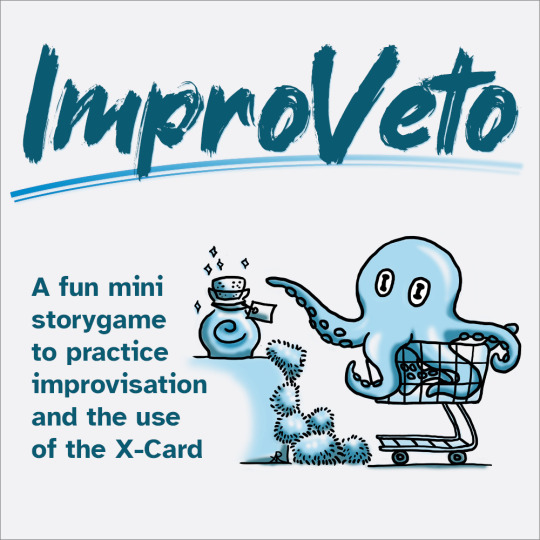
I thought I'd post a reminder of all the games you can get through us!
Viva la QueerBar is a story game about a queer bar and the team who runs it. GM-less one-shot for 2-6 players, Descended from the Queen mechanics. Written by Sandra Dahlhoff and Andrea Rick, cover art by Hannah van den Höövel.
Miss Bernburg's Finishing School for Young Ladies is a story game about the interpersonal drama at a boarding school for upper-class young women in the 1950s. GM-less one-shot or few-shot for 3-6 players, Firebrands mechanics. Written by Andrea Rick, cover art by Christiane Ebrecht.
Bunny, We Bought a Dungeon is an OSR map-drawing story game about anthropomorphic bunnies who bought a dungeon to move in there together. GM-less one-shot for 2-6 players, D6 dice pool mechanic. Written by Jasmin Neitzel and Andrea Rick, cover art from the Public Domain.
Dolly, We Bought a Dream House is a dream-house-drawing story game about Dollys in a pinktastic world who explore and furnish a Dream House together. GM-less one-shot for 2-6 players, D6 dice pool mechanic. Written by Jasmin Neitzel and Andrea Rick, cover art by Andrea Rick.
Magical Pets is a narrative TTRPG about pets at a magic school. One-shot or mini campaign for 2-6 players and 1 GM, Lasers & Feelings hack. Writing and art by Andrea Rick.
Rodents With Guitars is a narrative TTRPG about a group of rodents who want to win a guitar band contest. One-shot or mini campaign for 2-6 players and 1 GM, Honey Heist hack. Writing and art by Andrea Rick.
ImproVeto is a story game to practice collaborative storytelling (usually fun and absurd ones) and using the X-card. Warm-up or one-shot of 10-90 minutes, minimal mechanics. Writing and art by Andrea Rick.
---
We've also published the official German translation of Follow by Ben Robbins and are currently working on further translations into German (including Dream Askew/Dream Apart by Avery Alder and Benjamin Rosenbaum).
We'll be crowdfunding our next bilingual game Against the Monster/Gegen das Monster in February 2024 (separate post to come!).
You can buy all the games shown in this post through our website (most of them are available in print and PDF). Digital versions (all screenreader-ready with image descriptions, PDF tags, etc.) and more detailed descriptions in English are also available on Itch.io.
#ttrpg#indie ttrpg#plotbunny games#viva la queerbar#miss bernburg's finishing school#bunny we bought a dungeon#dolly we bought a dream house#magical pets#rodents with guitars#viva la queer bar#story games#frlbernburgs#followrpg
18 notes
·
View notes
Text

Beyond The Pale is a tabletop RPG adventure inspired by Jewish history, folk tales, and mysticism. This setting aims to highlight the unique folklore and beliefs cultivated by the Jewish people, presenting them in an old-school RPG format. It explores themes of oppression and persecution alongside hope and love, set against a backdrop of idyllic country life.

Azazel, King of Scapegoats
To ensure the authenticity and sensitivity of this portrayal, the core development team (including the writing, art, and layout) all identify as Jewish. Members of the religious community were consulted throughout the development of this book to ensure that the themes and images represented in the text were not perceived as offensive or derogatory.
The adventure was written with Cairn in mind, but is close to being system-neutral and easily adapted to other “Old School” roleplaying games. The book will be about 94 pages. A5 size.
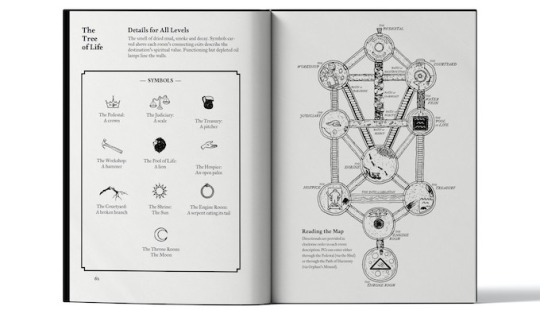
Explore the Tree of Life

The events of this module take place during a week-long celebration, the Days of Remembrance, during which the PCs will need to gather information, solve mysteries, and overcome threats to prevent a great cataclysm.

A map of the region
The places in this book are based on an actual territory in the western part of the Russian Empire known as The Pale of Settlement, which existed from 1791 to 1917. For over a century, Jews were restricted to this region. Jews often lived together in small, market towns called shtetls. During that time, hundreds of thousands of Jews were killed as a result of pogroms. Even with these restrictions, Jews in Europe were able to cultivate a rich culture and language. The village in this adventure, Kest, is based on one such place.

A groschen, the local currency

The village of Kest and the surrounding countryside is populated with all manner of folk: erudite scholars, scheming politicians, jealous tricksters, lumberers, labor activists, folk witches, and many, many more! As they move about the countryside, characters will explore ancient ruins, dark forests, and broken lighthouses in their efforts to prevent - or assist - in a cataclysmic event.
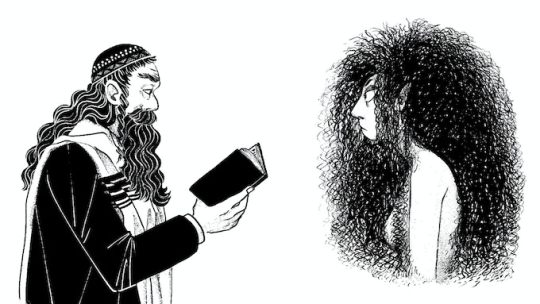


Rifka. She carries a secret.

The setting of Beyond the Pale is populated by all manner of creatures, beasts, and monsters. The vast majority of these creatures are the result of meticulous research and study of Jewish folktales, myth, and legend. As the PCs explore the town, the forest, and the dungeons of the Pale they will encounter beasts unfamiliar and wild: an unrelenting dybbuk, a vengeful mazzik, the malicious Alukah, and many more.

Some of the creatures you'll meet in the Pale

At its core, Beyond the Pale is still an old school adventure. Characters are expected to explore deadly dungeons, surviving on wit, critical thinking, and a bit of luck. The book will feature two distinct dungeons for the PCs to explore, each designed around a real symbol of Jewish identity.
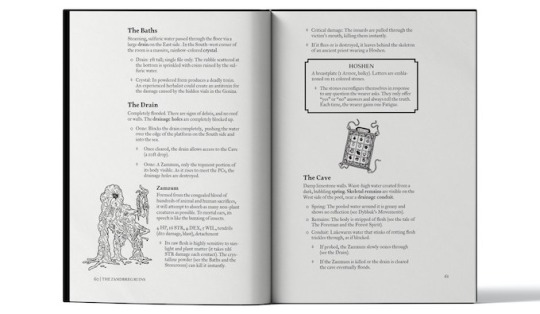


All of the magic items in Beyond the Pale are sourced directly from Jewish esoterica, belief, folk tales, and mysticism. Two years were spent researching and writing this book, great care has been taken deciding how to represent some of the symbols, imagery, and personalities include in the book.


Some of the relics the characters may discover

Kickstarter campaign ends: Thu, December 21 2023 10:00 AM UTC +00:00
Website: [Lost Pages] [twitter] [instagram]
26 notes
·
View notes
Text
Also heres some star ratings from shows i've watched recently that I havent made any real post about because idk man im balls deep in OSRS atm.
IWGP Women's Championship Mayu Iwatani (c) v. Toni Storm Nagoya Golden Fight | STARDOM 3.75 stars
Miu Watanabe & Miyu Yamashita v. Meiko Satomura & Shoko Nakajima All Rise | TJPW 4 stars
IWGP World Heavyweight Championship Tetsuya Naito (c) v. Zack Sabre Jr. King of Pro Wrestling | NJPW 4.25 stars
DPW Superbattle 19/10/24
Six Man Tag Team Match 1 Called Manders, BK Westbrook & Thomas Shire vs. Leon Slater & Lykos Gym (Kid Lykos & Kid Lykos II) 3 stars
Tag Team Match Alex Windsor & Emi Sakura vs. Danni Bee & Hyan 3.25 stars
Singles Match KENTA vs. Kevin Blackwood 3.75 stars
DPW National Title #1 Contendership Match Mike Bailey vs. LaBron Kozone 4.25 stars
Battle Of The Best Final Match Shoko Nakajima vs. Dani Luna 4.25 stars
DPW National Title Match Masato Tanaka vs. Adam Priest 4 stars
Tag Team Match FTR (Cash Wheeler & Dax Harwood) vs. Violence Is Forever (Dominic Garrini & Kevin Ku) 4.5 stars (AEW need to sign VIF NOW!)
DPW Worlds Title Match Calvin Tankman (c) vs. Jake Something 4.5 stars
AEW Continental Championship Kazuchika Okada (c) v. Kyle O'Reilly Battle of the Belts XII | AEW 4 stars
MLP Forged in Excellent Night 1 and 2
Singles Match Miyu Yamashita vs. Gisele Shaw 3.25 stars
Singles Match Mike Bailey vs. Konosuke Takeshita 4.75 stars
Singles Match El Phantasmo vs. Mike Bailey 4 stars
ROH Women's World Title Match Athena (c) vs. Gisele Shaw 4 stars
AEW International Title Match Konosuke Takeshita (c) vs. Josh Alexander 4.75 stars
WHAT ELSE HAS HAPPENED RECENTLY FUCK ME IM TRYING TO THINK I SHOULD HAVE WROTE IT DOWN FUCK!
fuck it thats all your getting enjoy.
#aew#njpw#mlp#oh my god im gonna have to tag it as mlp fuck#maple leaf pro wrestling#mlpw#star ratings#stardom#dpw#DPW PROMOTION OF THE YEAR BTW WHAT THE DAWG DOIN URA URA URA#tjpw
4 notes
·
View notes
Text
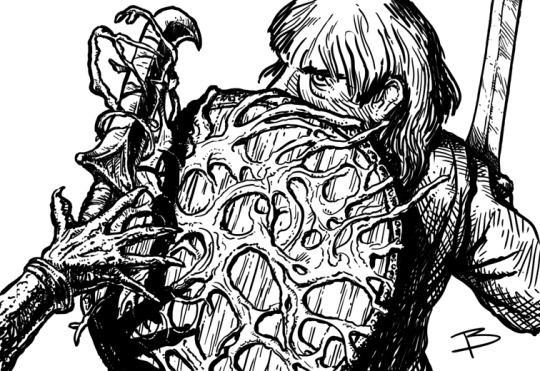
A Vine Shield. I drew this awhile ago for The Bizarre Brochure, a team project created by the OSR New Art discord channel. This is a freebie PDF containing monsters, magic items, some NPCs and a few dungeon maps. You can get it here.
20 notes
·
View notes